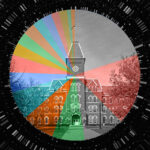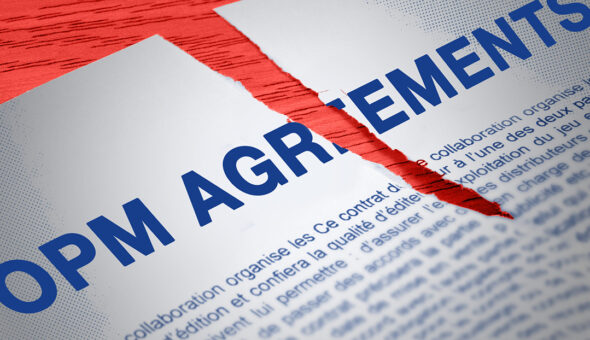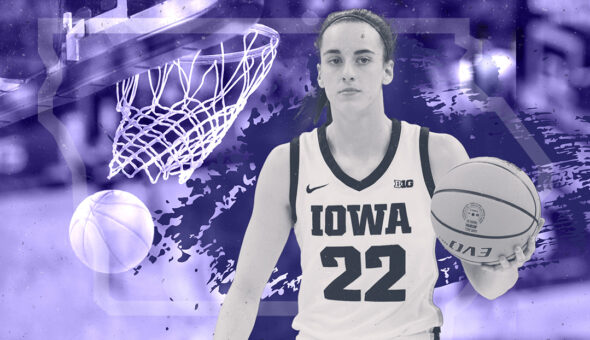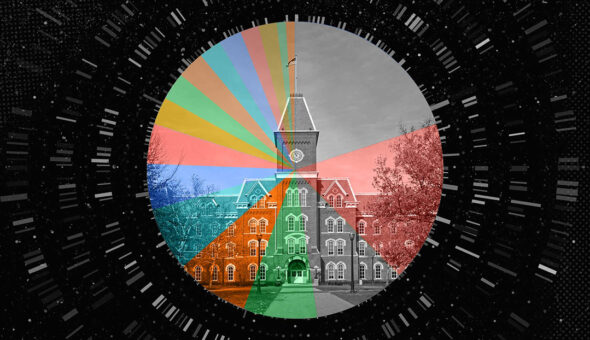I still remember it vividly.
I was at the 2019 AMA Symposium for the Marketing of Higher Education. The session I was attending promised to showcase how an in-house marketing team brought their institution to a national stage. It was standing room only and I was smashed somewhere between a doorway and a second row of sitting people.
For the next 45 minutes I experienced a kaleidoscope of emotions; awe, inspiration, joy. And when the speaker unveiled the tagline of “Ambition Can’t Wait” — I experienced a tinge of jealousy.
It was smart. It was creative. It was so good.
Drexel University’s campaign represented so much of what I love about higher ed marketing: the collision of creativity and our cause. Not only did this raise the bar creatively, it reinforced the power of higher education, itself, through its institutional message. That campaign, launched in 2016, continues today.
With that inspiration in mind, and to bring a little celebration to our craft, I’ve compiled this list of nine other great marketing campaigns and taglines from higher ed that take big ideas, wed them to brand identities, and have been expertly brought to the big stage.
Colby College: Dare Northward
If Drexel’s presentation wasn’t inspirational enough, Colby College’s “Dare Northward” presentation blew the lid off the room that year at AMA. The student profiles remain forever lodged in my mind. What started as a capital campaign has, ultimately, become the voice of the brand. What the campaign has shown are the powerful ways strategy can become a launchpad for incredible stories. If the quickest way to the head is the heart, the emotional levers we pull through powerful stories is the rocket fuel to put us on that path, and this campaign demonstrates that.
Indiana Tech: “Go For It”
How often do we hear that a brand must be authentic, that it must truly embody who and what it is representing? In the case of Indiana Tech, “Go for IT” showed a clear ownership of who they are. What prompted the campaign was the need to clear up confusion in the market. With “Tech” in the name, degree and institution type weren’t clear.
The solution was not only a campaign that got to the heart of what Indiana Tech offers, but the campaign’s supporting messages (Tech is Everything and Tech is in Our Name) uplifted all of Indiana Tech’s proof points through the lens of technology. I’d like to think of brand strategy as the bridge between institutional strategy and marketing. “Go for IT” proves that getting to the heart of your offering — in this case, a near literal interpretation — can be our most powerful position.
University of Wyoming: The World Needs More Cowboys
I can’t remember the last time a higher ed campaign received as much publicity as University of Wyoming’s “The World Needs More Cowboys.” It was said to have generated more than $6.1 million in news coverage, and the campaign proves how fame is one of the most impactful contributions advertising can make. I genuinely loved every bit of it. It was so wonderful because it was so not higher ed — but at the same time so higher ed.
Read: Designing Better Higher Ed Brands
In fact, this campaign is higher ed’s contribution to #advertisingtwitter’s decade-long ‘should you be distinct or different’ debate. Like all Twitter debates, this is one rather polarizing, however, there is a small faction furiously noting “why not do both? Why not use distinction to be different. The literature would argue that without some creative guardrails in one’s quest to become different, you run the risk of losing a connection to the category. One the other hand, breaking category conventions puts us in a better position to stand out. It’s why this campaign is brilliant: It does both.
University of Virginia Darden School of Business: Put Your Why to Work
Not only should a brand or campaign platform inspire your external audiences, it should inspire internal one’s, as well. Done well, a creative team should have no trouble coming up with creative ideas, whether it’s copy, design or campaigns that ladder up. Watching “Put Your Why to Work” evolve from the school level down to specific programs and across web content has been inspiring. As much as we may have skimmed through the ‘consumer behavior’ chapter in our marketing textbooks, in most, there’s usually a small section on cost signaling. In marketing, the creative decisions we make and the media we choose to embed those messages in, send status signals. This creative isn’t just inspiring, but its execution also sends the right signals to reinforce Darden’s top spot in the market and perceived value.
Purdue University: “The Next Giant Leap”
If we are talking about big brand ideas, there’s none more quintessential than what Purdue University has done with the “The Next Giant Leap,” a platform meant to elevate the institution’s world-class innovations. It’s become a launchpad for so many incredible conversations around what it means to be committed to a purpose, for both the institution as well as it’s students, that it has earned them a spot on Fast Company’s Brands that Matter list.
Watch: 20 Questions with Purdue’s SVP of Marketing & Communications
In terms of brand strategy, there’s also nothing more impactful than a consistent and distinct delivery across all marketing and communication efforts – and it all looks too consistent for this not to be the “marketing engine” that’s driving key marketing decisions. From Protect Purdue to the Persistent Pursuit and everything in between, it’s clear that this platform isn’t just flavoring brand communications but, instead, driving actual institutional behaviors — and it’s been fun to watch.
Sweet Briar College: “Women Making History”
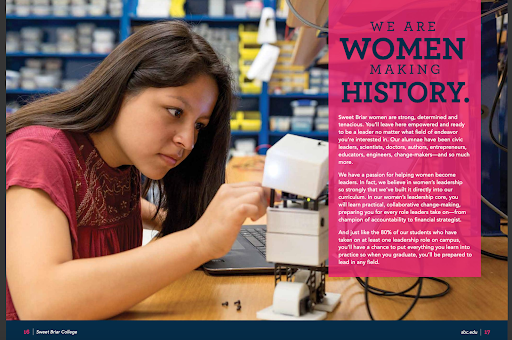
Sweet Briar College is a private women’s college in Virginia. After nearly closing its doors, a combination of enrollment strategy, new leadership and community and campus support helped to not only keep the doors open, but emerge revitalized. With the resurgence of the institution, came a new brand platform anchored in a big brand campaign.
Read: Is it a Product or Service? The Hybrid Higher Ed Brand
“Women Making History” is as distinctive as it is defining, the perfect combination needed to stand out in a highly competitive arena. The tagline is confident and courageous and perfectly aligns with their promise, being “fiercely committed to your individual growth.” What’s equally powerful are the messaging and visual elements that help to reinforce the campaign’s tagline.
Northwestern University McCormick School of Engineering: Whole-Brain Engineering
This campaign has been in the market since 2017, and it continues to inspire. Big ideas are powerful because they are timeless, most often built on tension or an insight that traces the faultlines of an emerging cultural, industry or economic trend. The beauty here is that this is a bit of all three — and is category-defining among competitor engineering programs.
University of Rhode Island: “Calling All Big Thinkers”
Our perception of a brand is shaped, unconsciously, through every single experience. To put it succinctly – brand is everything. And it’s in our power to craft – through our brand messages – each touchpoint to build a narrative that strengthens that experience.
Listen: Why is it So Hard for Colleges to Differentiate Themselves?
I remember seeing the “Calling all Big Thinkers” campaign highlighted in a Tweet – and, of course, spent the next hour or so learning as much as I could about the campaign. Not only was I incredibly impressed that this herculean task appeared to be primarily the work of an internal team but also how the campaign evolved across each and every creative package.
From billboards to Instagram Stories ads, the campaign was well executed and I was impressed how they extended the primary campaign message into departmental messaging, creating a cohesive campaign no matter where the advertising originated. The campaign was anchored to a portfolio of student stories in an attempt to get prospective students to see themselves at URI. Not only did the campaign creatively build repetition, but the continued use of the same students across campaign assets built fluency.
University of South Carolina: “The Remarkably We”
Having received a few degrees from U of SC and having worked previously at the institution in a marketing role, I still feel a sense of ownership over any branding efforts from my alma mater but promise that despite my attachment this is purely objective. Not only is this campaign incredibly bold, but there’s an element of pride involved when I see it (And I promise that’s as an alumnus).
Understanding the role that a state flagship plays and the myriad of stakeholders involved, the idea of “We” encapsulates so much of who the institution is as well as where “We” can be applied.
In Walter Dill Scott’s 1903 the “Psychology of Advertising,” he wrote that advertising works by creating the right kind of associations — the stuff we want to be known for and the stuff we need to continually weave through all our communications to strengthen it over time. Whether borrowed (i.e. Cowboys) or built (i.e. Whole-Brain Engineers) these associations close the gap between what our conscious minds tell us to do and our subconscious processes. Put differently, branding’s biggest impact is on our subconscious, which most often helps us build a post hoc explanation for a decision. How we communicate – our marketing – is an investment in brand building and it’s these examples that show how big ideas pay dividends.




